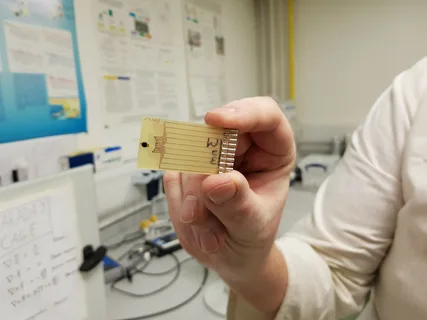A breakthrough diagnostic method for detecting bacteria in blood has been developed by two doctors in northern Norway. Hege Harboe-Sjåvik at Helgeland Hospital Trust and Kristoffer Hammer Endresen at Nordland Hospital Trust, in collaboration with CANS—Centre for New Antibacterial Strategies at UiT The Arctic University of Norway, have successfully tested a new analysis method called BCID2 for detecting bacteria in blood samples.
Sepsis is a life-threatening condition that occurs when the body’s response to infection causes injury to its own tissues and organs. It is estimated that there are around 49 million cases of sepsis globally every year, resulting in 11 million sepsis-related deaths. This accounts for 20% of all global deaths, making it a significant public health issue.
In order to effectively treat sepsis, it is crucial to quickly identify the bacteria causing the infection and administer the appropriate antibiotics. The new BCID2 method aims to provide faster and more accurate results compared to traditional diagnostic methods.
During the coronavirus pandemic, the BCID2 method was utilized for analyzing COVID-19 tests at several smaller hospitals. The doctors wanted to determine whether this method could also be used for rapid analysis of sepsis in smaller hospitals, instead of sending samples to larger laboratories.
To evaluate the effectiveness of the BCID2 method, the researchers reviewed the results from 160 blood samples with bacteria taken at Helgeland Hospital Trust from July to December 2021. Rapid tests were conducted at the local hospitals, while standard tests were carried out at a microbiological laboratory at a regional hospital.
The doctors received the test results two days earlier than before, and the accuracy of the results was comparable to the tests conducted at the larger laboratory. Additionally, in one out of four cases, the new method provided the possibility of better antibiotic treatment for the patient.
The findings suggest that the BCID2 method is a robust and accurate addition to traditional diagnostics for quickly detecting bacteria in blood samples. This has the potential to improve patient treatment for suspected sepsis at local hospitals, particularly those located far from larger laboratories. The faster results can make a significant impact on seriously ill patients, providing more equitable and timely care without the need for transferring patients or healthcare personnel between hospitals.
Furthermore, the new method offers opportunities for more targeted antibiotic use, potentially reducing the unnecessary use of broad-spectrum antibiotics at local hospitals. This is crucial in the fight against antibiotic resistance.
The study showed that in less than 3% of cases, the new test failed to detect the bacteria present in the blood. There were no cases where the rapid test indicated the presence of bacteria when there were none, eliminating false positives.
Overall, the BCID2 method has great potential to enhance sepsis diagnosis and treatment at local hospitals. The faster and more reliable results can save lives and improve patient outcomes. Additionally, the method’s ability to provide targeted antibiotic treatment can contribute to reducing antibiotic resistance. The researchers believe that further implementation of this innovative diagnostic tool can revolutionize sepsis management and improve healthcare services for patients worldwide.
*Note:
1. Source: Coherent Market Insights, Public sources, Desk research
2. We have leveraged AI tools to mine information and compile it


